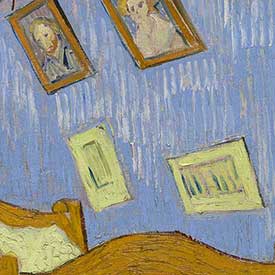The portraits
A picture is worth a thousands words—an adage that rings true of these pictures within pictures. One of the more noticeable changes among the three different versions are the portraits that hang above the bed, clear indicators of Van Gogh's state of his mind—his early hope when he painted the first version and his decidedly less optimistic view 11 months later when he painted the second and third versions.
In the first Bedroom, Van Gogh—full of excitement at just having moved into his Yellow House—faithfully recorded the portraits that hung on the wall of his new bedroom; one is of Eugène Boch and the other is Lieutenant Paul-Eugène Milliet. The artist hoped to develop a community of artists in Arles, and these portraits embody the spirit of camaraderie he hoped would fill his home.
Painted after a mental breakdown and the shattering of his "Studio of the South" dream, the second and third versions pair self-portraits with imagined portraits of unidentified women. Together the images may represent the domestic pairing that the artist had once sought but now considered impossible to obtain.
Discover more illuminating differences among these objects:






© Art Institute of Chicago